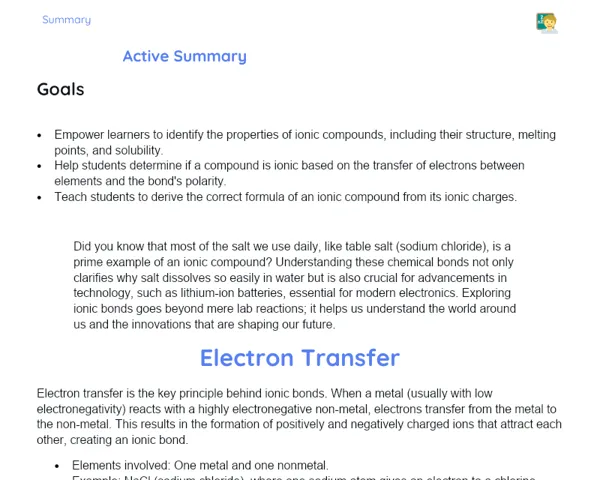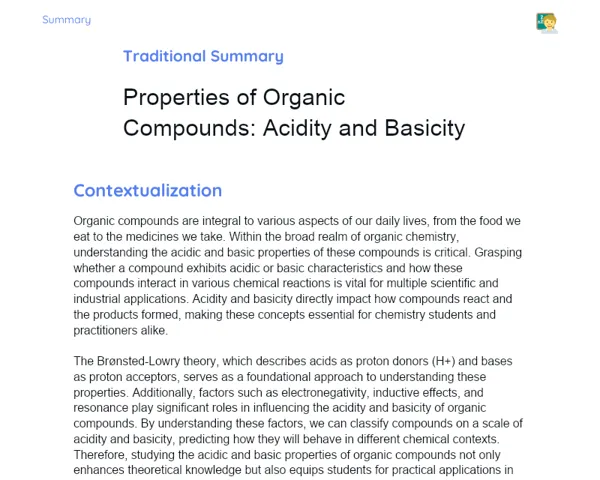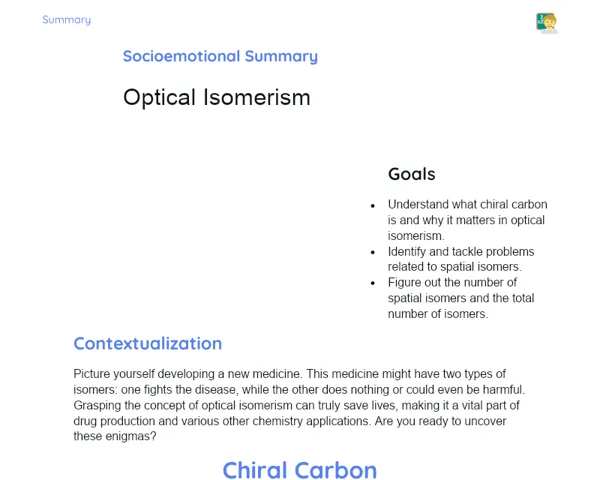Socioemotional Summary Conclusion
Goals
1. Grasp the application of the Nernst equation to calculate potential differences under non-standard conditions.
2. Identify the factors involved in the Nernst equation and their influence on electrochemical potential.
3. Foster socio-emotional skills through the RULER method, with a particular focus on managing and expressing emotions when faced with academic challenges.
Contextualization
Did you know that the electronic gadgets you use every day, such as your smartphone, rely on electrochemical principles? The Nernst Equation is pivotal for understanding how batteries maintain their charge and supply energy. Just as the elements of a battery need to be balanced for effective functioning, we too must manage our emotions to effectively tackle challenges. Let's delve into this fascinating topic and discover how it relates to both chemistry and our everyday lives!
Exercising Your Knowledge
Nernst Equation
The Nernst equation is a key mathematical formula used to calculate the electrode potential of an electrochemical cell under non-standard conditions. This equation considers the concentration of the ions involved and temperature, enabling precise predictions of electrochemical behaviour in real-world scenarios.
-
E = E° - (RT/nF) * lnQ: This standard formula shows how each variable plays a critical role in determining potential.
-
Gas Constant (R): Set at 8.314 J/(mol·K), this constant is crucial for accurately computing electrode potential.
-
Temperature (T): Measured in Kelvin (K = °C + 273), temperature has a direct impact on potential outcomes.
-
Number of Electrons Transferred (n): This value, which varies depending on the specific redox reaction, is essential for correctly applying the equation.
-
Faraday Constant (F): With a value of 96485 C/mol, it represents the charge of one mole of electrons.
Reaction Quotient (Q)
The Reaction Quotient (Q) is the ratio of the concentrations of products to reactants, raised to their respective stoichiometric coefficients. Q is vital for determining the potential of a cell in any state, not just under standard conditions.
-
Q = [Products] / [Reactants]: This represents the ratio between the concentrations of products and reactants, adjusted by their coefficients.
-
Importance of Precision: A slight change in the concentration of reactants or products can greatly affect the value of Q, and thus the electrode potential.
-
Impact on Potential: If Q is greater than 1, products are favoured; if Q is less than 1, it indicates a higher concentration of reactants.
Standard Potential (E°)
Standard Potential (E°) is the electrode potential measured under standard conditions (1M concentration, 1 atm pressure, at 25°C). It serves as a crucial reference for determining potential under non-standard conditions using the Nernst equation.
-
Standard Potential Table: E° values for various electrodes are tabulated and serve as reference points.
-
Comparison and Prediction: E° allows for comparison of different chemical species' tendencies to gain or lose electrons.
-
Importance in Practice: This data is essential for assessing the feasibility of reactions in various real-world conditions.
Key Terms
-
Electrochemistry
-
Nernst Equation
-
Reaction Quotient (Q)
-
Standard Potential (E°)
-
Gas Constant (R)
-
Faraday Constant (F)
For Reflection
-
How do the variables in the Nernst equation connect to the different factors that influence our daily emotions?
-
In what ways does the balance required in electrochemical reactions mirror the need for emotional stability in our lives?
-
What strategies for solving complex electrochemical issues can we adapt to handle emotional and social challenges?
Important Conclusions
-
The Nernst equation is fundamental for calculating the potential difference of electrodes in non-standard conditions, considering factors like ion concentration and temperature.
-
A solid understanding of the factors in the equation, such as the Gas Constant, Faraday Constant, and Reaction Quotient (Q), is necessary for proper application.
-
Developing socio-emotional skills, including emotional regulation and self-awareness, is essential for tackling both academic and personal challenges.
Impacts on Society
The implications of the Nernst equation are significant today. It's relevant in optimising batteries critical for the electronics we rely on daily, such as phones, laptops, and electric vehicles. Grasping this equation paves the way for advancements in energy efficiency and the development of sustainable technologies, contributing to a greener and innovative future. Furthermore, studying the Nernst equation can serve as a valuable metaphor for recognising the importance of balance in our emotional lives. Just like a battery requires an adequate mix of reactants and products to function effectively, we need to manage our emotions to maintain our well-being. This analogy helps students connect emotionally with the subject, appreciating how balance is crucial in both the fields of chemistry and social interactions, as well as personal growth.
Dealing with Emotions
To support emotional management while studying the Nernst equation, I suggest the following exercise based on the RULER method. Start by acknowledging the emotions you experience when tackling challenging electrochemistry problems. Ask yourself: 'Am I feeling anxious, frustrated, or confident?' Identify the reasons behind these feelings and recognise what triggers them. Clearly define each emotion that surfaces. Find an appropriate way to express your emotions, such as talking to a friend or jotting them down in a journal. Lastly, regulate your emotions with techniques like deep breathing, taking necessary breaks, and asking for help when needed. This process will aid your focus and calm during your studies.
Study Tips
-
Form a study group with classmates to discuss and solve electrochemistry problems on a regular basis. Sharing insights and experiences can enhance your understanding of the Nernst equation.
-
Leverage online resources, such as educational videos and electrochemical reaction simulators, to visualise how the Nernst equation applies to real situations, which aids in solidifying your learning.
-
Divide your study time into manageable blocks and include regular breaks. This strategy helps you avoid mental fatigue and enhances content retention, while also keeping productivity high.



